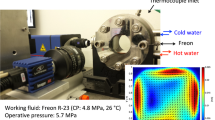Abstract
Particle image velocimetry is used to investigate the interaction between an incident shock wave and a turbulent boundary layer at Mach 2.1. A particle response assessment establishes the fidelity of the tracer particles. The undisturbed boundary layer is characterized in detail. The mean velocity field of the interaction shows the incident and reflected shock wave pattern, as well as the boundary layer distortion. Significant reversed flow is measured instantaneously, although, on average no reversed flow is observed. The interaction instantaneously exhibits a multi-layered structure, namely, a high-velocity outer region and a low-velocity inner region. Flow turbulence shows the highest intensity in the region beneath the impingement of the incident shock wave. The turbulent fluctuations are found to be highly anisotropic, with the streamwise component dominating. A distinct streamwise-oriented region of relatively large kinematic Reynolds shear stress magnitude appears within the lower half of the redeveloping boundary layer. Boundary layer recovery towards initial equilibrium conditions appears to be a gradual process.













Similar content being viewed by others
References
Andreopoulos J, Muck KC (1987) Some new aspects of the shock wave/boundary layer interaction in compression flows. J Fluid Mech 180:405–428
Ardonceau PL (1983) The structure of turbulence in a supersonic shock wave/boundary layer interaction. AIAA J 22(9):1254–1262
Ardonceau P, Lee DH, Alziary de Roquefort T, Goethals R (1980) Turbulence behaviour in a shock-wave/turbulent boundary layer interaction. AGARD CP-271, paper no. 8
Beresh SJ, Clemens NT, Dolling DS (2002) Relationship between upstream turbulent boundary-layer velocity fluctuations and separation shock unsteadiness. AIAA J 40(12):2412–2422
Cebeci T, Cousteix J (1999) Modeling and computation of boundary layer flows. Horizon, Long Beach
Chapman DR, Kuehn DM, Larson HK (1958) Investigation of separated flows in supersonic and subsonic streams with emphasis on transition. NACA report 1356
Dolling DS (2001) Fifty years of shock wave/boundary layer interaction research: what next? AIAA J 39(8):1517–1531
Dolling DS, Murphy MT (1983) Unsteadiness of the separation shock wave structure in a supersonic compression ramp flowfield. AIAA J 21(12):1628–1634
Délery J, and Marvin JG (1986) Shock-wave boundary layer interactions. AGARDograph 280
Dupont P, Haddad C, Debiève JF (2006) Space and time organization in a shock-induced separated boundary layer. J Fluid Mech 559:255–277
Elsinga GE, van Oudheusden BW, Scarano F (2005) Evaluation of aero-optical distortion effects in PIV. Exp Fluids 39:246–256
Erengil ME, and Dolling DS (1993) Physical causes of separation shock unsteadiness in shock wave/turbulent boundary layer interactions. AIAA paper 93-3134, Orlando, Florida
Garnier E, Sagaut P (2002) Large eddy simulation of shock/boundary-layer interaction. AIAA J 40(10):1935–1944
Green JE (1970) Interactions between shock waves and turbulent boundary layers. Prog Aero Sci 11:253–340
Haddad C (2005) Instationnarités, mouvements d’onde de choc et tourbillons a grandes echelles dans une interaction onde de choc/couche limite avec décollement. PhD thesis, L’Université de Provence, France
Holder DW, Pearcy HH, Gadd GE (1955) The interaction between shock waves and boundary layers. ARC technical report
Hou YX, Clemens NT, Dolling DS (2002) Development of a multi-camera PIV imaging system for studies of shock/boundary layer interactions. AIAA paper 2002-3232, St Louis, Missouri
Hou YX, Clemens NT, Dolling DS (2003) Wide-field PIV study of shock-induced turbulent boundary layer separation. AIAA paper 2003-0441, Reno, Nevada
Johnson DA (1974) Turbulence measurements in a Mach 2.9 boundary layer using laser velocimetry. AIAA J 12(5):711–714
Knight DD, Degrez G (1998) Shock wave boundary layer interactions in high speed flows: a critical survey of current numerical prediction capabilities. Advisory report 319, AGARD 2:1.1–1.35
Melling A (1986) Seeding gas flows for laser anemometry. In: Proceedings on the conference of advanced instrumentation for aero engine components. AGARD CP-399, 8.1
Meyer MJ, Butler TA, Bowersox RDW (1997) Compressible turbulence measurements in a supersonic boundary layer with impinging shock wave interactions. AIAA Paper 97-0427, Reno, Nevada
Moderass D, and Johnson DA (1976) Investigation of shock-induced separation of a turbulent boundary layer using laser velocimetry. AIAA paper 76-374, San Diego, California
Petrie HL, Samimy M, Addy AL (1986) Compressible separated flows. AIAA J 24(12):1971–1978
Raffel M, Willert C, Kompenhans J (1998) Particle image velocimetry: a practical guide. Springer, Heidelberg
Rose WC, Johnson DA (1975) Turbulence in a shock-wave boundary-layer interaction. AIAA J 13(7): 884–889
Pirozzoli S, Grasso F (2006) Direct numerical simulation of impinging shock wave/turbulent boundary layer interaction at M = 2.25. Phys Fluids 18:065113
Scarano F (2002) Iterative image deformation methods in PIV. Meas Sci Technol 13:R1–R19
Scarano F, Riethmuller ML (2000) Advances in iterative multi-grid PIV image processing. Exp Fluids 29:S051
Scarano F, van Oudheusden BW (2003) Planar velocity measurements of a two-dimensional compressible wake flow. Exp Fluids 34:430–441
Schaaf SA, Chambre PL (1958) Fundamentals of gas dynamics. Princeton University Press, Princeton
Schrijer FFJ, Scarano F, van Oudheusden BW (2006) Application of PIV in a Mach 7 double-ramp flow. Exp Fluids 41:353–363
Settles GS, Dodson LJ (1991) Hypersonic shock/boundary layer database. NASA CR 177577
Smits AJ, Dussuage JP (2006) Turbulent shear layers in supersonic flow, 2nd edn. American Institute of Physics, New York
Spalding DB (1961) A single formula for the law of the wall. J Appl Mech 28:455–457
Thomas FO, Putman CM, Chu HC (1994) On the mechanism of unsteady shock oscillation in shock/wave turbulent boundary layer interaction. Exp Fluids 18:69–81
Ünalmis ÖH, Hou YX, Bueno PC, Clemens NT, Dolling DS (2000) PIV investigation of role of boundary layer velocity fluctuations in unsteady shock-induced separation. AIAA paper 2000-2450, Denver, Colorado
Urban WD, Mungal MG (2001) Planar velocity measurements in compressible mixing layers. J Fluid Mech 431:189–222
White FM (1991) Viscous fluid flow. McGraw-Hill, New York
Acknowledgments
This work is supported by the Dutch Technology Foundation STW under the VIDI-Innovation Impulse program, grant DLR.6198.
Author information
Authors and Affiliations
Corresponding author
Rights and permissions
About this article
Cite this article
Humble, R.A., Scarano, F. & van Oudheusden, B.W. Particle image velocimetry measurements of a shock wave/turbulent boundary layer interaction. Exp Fluids 43, 173–183 (2007). https://doi.org/10.1007/s00348-007-0337-8
Received:
Revised:
Accepted:
Published:
Issue Date:
DOI: https://doi.org/10.1007/s00348-007-0337-8




